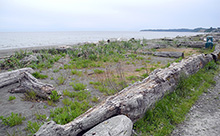Coastal Sand Dune
 There are several ecosystems found in and around Esquimalt Lagoon. Along the outer shore of Coburg Peninsula, the barrier spit that forms the seaward boundary of the lagoon, there is a narrow strip of coastal dune ecosystem. This fragile ecosystem is rare along coastal BC, and very susceptible to damage by invasion of exotic species and trampling by the many people who come here for recreation.
There are several ecosystems found in and around Esquimalt Lagoon. Along the outer shore of Coburg Peninsula, the barrier spit that forms the seaward boundary of the lagoon, there is a narrow strip of coastal dune ecosystem. This fragile ecosystem is rare along coastal BC, and very susceptible to damage by invasion of exotic species and trampling by the many people who come here for recreation.
Coastal Douglas-fir Forest
Upland from the lagoon on lands now occupied by Royal Roads University, are some of the best examples in the region of the Coastal Douglas-fir ecosystem. Towering Douglas-fir, western red cedar, western hemlock, Pacific maple and other trees, and associated understory shrubs are common there, as well as several wetlands. Many groundwater-fed streams emerge along the bluffs behind the lagoon, where skunk cabbage, red alder and red-osier dogwood proliferate. Riparian ecosystems are found along Bee Creek and Colwood Creek, which both enter the lagoon through small estuaries.
Marine Ecosystems
Surrounding the lagoon along the intertidal flats are wide swaths of salt marsh, especially along the inner shores of Coburg Peninsula. This ecosystem provides important habitat for the many migratory and resident birds that are found in Esquimlat Lagoon. The lagoon itself is a fairly shallow protected marine ecosystem, where eelgrass meadows cover about 15 hectares or 19% of the substrate. Strong tidal currents at the narrow entrance to the lagoon create ideal conditions for growth of kelp and other seaweeds, as well as a variety of marine invertebrates.
Read more about the diverse ecosystems of Esquimalt Lagoon.